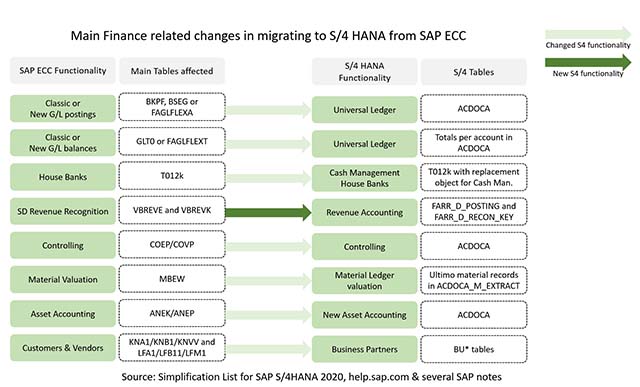Closing the Customer Experience Gap
SAP Experts Share Advice to Begin Investing in and Transforming the Customer Experience
SAP customers that are operating with non-integrated disparate systems and departments disconnected in silos organizationally and technologically are creating a disjointed customer experience (CX) in today’s everchanging landscape of customer demands. Those organizations need to find new ways to capture the exponentially growing amount of customer data, integrate their isolated systems, and achieve a single view of the customer. A major challenge out of the gate is how to secure budget for projects aimed at achieving an improved customer experience. Many companies are talking about doing more with less and improving customer satisfaction, but few seem to be allocating budget to reach this end.
For an upcoming state-of-the-market report, SAPinsider surveyed 150 SAP customers and interviewed a portion of these survey respondents as well as industry and SAP experts to understand how businesses are transforming the customer experience. This survey examined the drivers, benefits, strategies, and technologies that organizations are using to improve the customer experience as well as the significant challenges they face, such as evolving internal and external requirements. With organizations constantly changing themselves — including new products launched by marketing and new promotions and discounts offered by salespeople — and customers demanding more, how do business and IT departments ensure the right software solutions are in place to keep up with customer expectations and not lose out on opportunities?
Independent consultant Roberto Kirsten describes this feat well. “Managing the customer experience can never stop,” he says. “It’s a constant battle to provide what your clients need, and your clients’ behavior and expectations are always evolving.”
Explore related questions
To respond to evolving customer needs, companies need to take steps to improve the customer experience. And to do that, they need to allocate budget for CX projects. However, the SAPinsider survey results found that only 26% of respondents are currently investing in CX initiatives and could confidently say their organization has a dedicated CX budget. The reason for this low percentage of investment, as explained by respondents (see Figure 1), is due to a variety of factors such as competing priorities (26%), cost (19%), ignorance (17%), or satisfaction with their current software (11%). But the bigger question is — are their customers satisfied?

Figure 1 Factors survey respondents cited for their lack of investment in CX initiatives
According to Volker Hildebrand, Global Vice President, SAP Customer Experience, 80% of CEOs believe that their company delivers great customer experience — but, if you ask consumers how they rate their experience with that same company, only 8% would call it great. “This is what we call the experience gap,” he says. “Clearly, there is a big need to invest in CX initiatives because organizations are not meeting customer expectations. And if 80% believe they are delivering a great experience today, a lot of them may think they don’t have to invest in it, even though there is plenty of evidence that CX leaders outperform CX laggards significantly, creating value not only for their customers but also for their shareholders.”
Clearly more education is needed, and not just about the various CX solutions that are available. More broadly, organizations need to learn about what customer experience means and where precisely they can allocate budget for improvements, because the customer experience does not just happen in the front office — it touches many other parts of the organization beyond marketing, commerce, sales, and service. It’s also about operational excellence in making sure billing is sent correctly to customers, the online experience provides the convenience of one-click shopping, and the product is shipped through the supply chain in a timely manner. So, when organizations make investments in a new billing system or supply chain and logistics improvements, while the projects may not be categorized as CX investments, they are projects that directly influence the customer experience. For this reason, pieces like data management, e-commerce, and reporting are often bundled together as the foundation for a CX initiative.
Let’s look at some of the factors that are leading organizations to focus on their CX landscapes.
The Desire for Integration and a Single Customer View
More than half of the SAPinsider survey respondents said they use SAP solutions to create their customer experience, with the majority of these currently running SAP ERP 6.0 — less than 25% said they were already running SAP Business Suite on SAP HANA or SAP S/4HANA. One survey respondent is an agricultural chemical company that is running SAP ERP 6.0 and using SAP Customer Relationship Management (SAP CRM) and Microsoft as its CX solutions. According to the company’s SAP Logistic Manager, the business is currently growing and onboarding from an acquisition, and it wants to ramp up its CX capabilities and move to the cloud. “Integration is very important to the business, to ensure that marketing and customer service are not in silos but are able to talk to each other,” she says.
This company, which will be going live in July 2019 with a greenfield implementation of SAP S/4HANA and plans to look at the SAP Customer Experience suite — SAP C/4HANA — within the next 12-18 months, was in good company among the other 47% of survey respondents that listed integration as a major concern related to a planned or potential SAP C/4HANA implementation (see Figure 2). The only concern that beat out integration, not surprisingly, was cost of the project (65%), which resonates with the previously mentioned challenge of hard-to-obtain budgets for CX initiatives.

Figure 2 Concerns survey respondents cited related to a planned or potential SAP C/4HANA project
Data integration is becoming increasing difficult due to evolving customer demands and constant business changes. In the business-to-business (B2B) world, for instance, customer data is often represented differently across the multitude of systems that serve the customer, whether these are home-grown, best-of-breed, ERP, or even SAP Supply Chain Management (SAP SCM) systems. Over the years, those landscapes only got more complex, not simpler, according to Kirsten. “Say you implemented a new inventory management system and then created a customized representation in that system to support a certain customer,” he says. “Then, when you start making improvements in the front end that impact your client, all that customization has to be revisited.”
According to the SAPinsider survey results, if companies have CX budgets, they are more likely to invest in integration to avoid data issues. Of those respondents that are already investing resources, time, and money into CX initiatives, 21% are budgeting $500,000 or more for CX projects. And of these projects, many are investing in integration, with 11% more likely than the average to have built out custom integration to support a single view of the customer.
When survey respondents were asked to identify the top three CX strategies that are priorities at their organization, developing a real-time single view of the customer made the short list, with more than half of the respondents including it as a top strategy (51%). The other two strategies most commonly cited were integrating disparate systems and processes (59%) and enabling better data capture and reporting capabilities (66%).
With this many businesses prioritizing the importance of one source of the truth, it is a striking contrast that more than 75% of the respondents said they either did not currently have a single view of customer data, or did not know. Of the 22% that said they did have a single view, 78% said they achieved that view via custom integration into one or multiple platforms.
“For many organizations, simply having a single view of the customer is a big challenge,” says Hildebrand. “If the marketing organization has its marketing and leads database, the commerce system keeps track of what’s going on with the website, and the customer service organization has yet another system — and these systems are not integrated and there’s no single view of the customer — there is no shared insight into the fact that perhaps the customer made a purchase on the website two days ago. Often customers can get frustrated because the call center transfers them to another department, so they must explain the situation all over again, and typically that’s not a great customer experience. Simply bringing the customer data together will deliver a complete view of the customer journey and interactions to fully understand what has happened so far — and what it is that needs to happen next.”
Achieve a Complete View by Combining Experience Data with Operational Data
Hildebrand recommends that organizations maintain a sharp focus on combining experience data with operational data. “Managing CX data and feedback becomes so important because a lot of companies have primarily operational data and perhaps send out customer satisfaction surveys once and a while, but that doesn’t tell the full picture,” he says. “Organizations that are successful will combine the experience data from customers with their own operational data, so they can see all that is happening. Knowing operational data — such as revenues are going up, customer churn is increasing, or the average response times in customer service are going up or down — that information alone is helpful to a point. But to really get to the bottom of why customers are leaving or no longer buying from you, you need to have that experience data combined.”
This is an area in which Qualtrics solutions can help close the gap, according to Hildebrand, by enabling businesses to collect experience data at every touchpoint, understand issues, and take action. “Using Qualtrics together with the SAP Customer Experience suite allows you to proactively follow up with detractors or at-risk customers,” says Hildebrand, “or activate the entire organization to eliminate process bottlenecks, fix product issues, improve the skills of your service agents, and enhance the usability of your website.”
One of the big challenges for CX is that companies typically don’t see an immediate short-term financial impact. The impact is loyalty; customers come back and buy again, which could take months or even longer, so the business only sees the financial impact in long term. However, most of the financial metrics organizations have in place today are short term, primarily focused on the shareholders, so these metrics don’t necessarily reflect whether that organization is creating great customer experiences. Companies must have other metrics in place to know that they are improving and to see the financial impact in the long term.
A happy customer is a repeat customer. And simply closing out a customer service ticket successfully does not ensure a happy customer that will come back. Unless companies combine that operational data with experience data, they will never know if customers experienced frustration with a service rep, were delighted in how quickly a problem was solved, or were disappointed because it took much longer than expected. Solving a customer problem is only part of the equation. The other part is how quickly the problem was solved and how easy the process was for the customer. Achieving that complete CX centricity needs to be a directive coming all the way from the CEO, and one that then translates into the overall company strategy, culture, and even metrics coming back to that operational data, depending on what is being measured, according to Hildebrand.
“Something happening in the supply chain side of the business might be important to create a better CX because the operational excellence in your business processes that are related to customer orders — order management, supply chain, service requests, parts management and logistics, even billing — these can all be relevant,” Hildebrand says. “If you do customer feedback management right, you can pinpoint issues that have a significant impact on the overall CX. For example, if you identify parts logistics as a root cause for poor customer experience, you might recognize that’s an issue you need to address in the back office.”
Selecting the CX Initiatives to Tackle
In determining the CX projects to tackle first, there are many things to consider. For example, what technology actually has to be replaced? If something is approaching end of life, that’s a no-brainer. But what if an organization is running SAP CRM on premise to run a customer service center and it’s working great? Why replace it today just to go to the cloud? Even with incremental benefits, it could be a significant investment. Or perhaps some CX technology does only 80% of what a company wants today. How do they prioritize the projects to get to the long-term goal, while building mid-term and short-term initiatives to happen along the way? What should they focus on first? One consideration is whether to start with back-office projects or with customer-facing initiatives.
“Some organizations choose to start in the back office by doing an SAP S/4HANA implementation first, before an SAP C/4HANA deployment. However, this is not really a requirement and seems to be more IT driven,” says Hildebrand. “Customers don’t need to wait until they migrate to SAP S/4HANA. They can start with SAP Customer Experience in the front office. For example, they can start with a field service management solution today, which is tightly integrated with SAP ECC, and once the SAP S/4HANA migration is complete in the back office, they just need to change the connectors to SAP S/4HANA. More and more customers are realizing that sometimes they can innovate even faster in the front office first, and then do the back office later.”
While project cost surely comes into play in determining the initiatives to tackle first, the sheer number of projects is often overwhelming and can deter companies from taking those first steps. Kirsten stresses the importance of a well-defined roadmap in helping SAP customers prioritize their planned CX initiatives. “Companies are always busy with the day-to-day firefighting of their most pressing needs — they rarely have an opportunity to devise a roadmap that deploys incremental pieces of the overall CX strategy over a period of time,” he says. “Having a roadmap with well-defined projects that align with other business and IT initiatives and are rolled out over time, taking into account annual budgets, is a smart way to get CX initiatives under way.”
And these larger initiatives are usually longer-term projects, such as replacing existing marketing solutions or introducing new service solutions, which will take some time. But in the meantime, companies can start working in parallel on quick wins — such as chatbots or must-haves like data privacy tools — while they prepare to bring the big components together in end-to-end experience or technology suite in a two-year timeframe.
CX centricity must be a company-wide objective for all organizations that touch or affect the customer experience, according to Hildebrand, and the companies that are already working on integration and breaking down data silos have the different parts of the business all connected and working together. “Whether it’s the people truly in the front line, such as customer service, or those in the supply chain or warehouse, they need common goals and objectives,” he says. “And they need to have the right metrics in place, the willingness to work together, and the right incentives in place that encourages different units to collaborate.”
Taking the First Step
Not surprisingly, the first step to improve customer experience is to listen the customer — ask the customers what their biggest problems are today, and really listen to them. “Step one is identifying the most relevant customer issues, understanding what their expectations are, and discovering where you fail to meet those expectations, because these are the first things you want to fix — and many times, these are not very hard problems to fix,” Hildebrand says.






